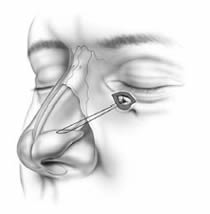Nasal Valve Suspensions Suture
Nasal airway obstruction (stuffy nose) is one of the most common complaints presented to an ear, nose and throat physician.
The differential diagnosis is quite extensive, including deviated septum (crooked cartilage and bone dividing the nasal passages), a growth in the nasal cavity or behind the nose, enlarged inferior turbinate’s (swollen structures on the inside of the nose that enlarge with allergy or a common cold) and finally nasal valve obstruction.

The nasal valve is located between the nasal septum and the side wall of the nose. Movement of the nasal valve occurs as a dynamic process when air is inspired naturally. However, when the nasal valve is narrowed (less than 10 degrees), patients complain of a stuffy nose constantly.
The most common surgery performed to correct nasal blockage is called a septoplasty and turbinate reduction. The surgery is performed as an outpatient under general anesthesia, takes less than 45 minutes and requires no nasal packing. In this practice, demand for this procedure is very high given the high success rate and the minimal recovery. Time off work usually is no more than an extended weekend (3-4 days), and the overall success rate is over 90%. For the small percentage of patients who do not respond, the problem usually involves the nasal valve.
The traditional manner to correct a narrowed nasal valve requires extensive surgery with a low success rate (50%). Cartilage is harvested from either the septum or ear and placed as a spreader graft in an attempt to widen the nasal valve. Dr. Hoffman at NAENTA abandoned this technique several years ago, since it usually requires an incision under the nose causing extensive swelling, and often does not work.
Dr. Hoffman observed an innovative technique to correct nasal valve narrowing at a surgical course 12 years ago and has perfected the procedure with over 900 cases to date. The surgery is called a nasal valve suspension suture. Unlike the spreader graft technique, the suspension suture is simple, quick and highly effective, with a success rate of 90-95 %.
The suspension surgery involves placement of a suture through a very small incision under the eye, hidden in a skin crease. In over 900 cases, the small incision has universally healed beautifully. The suture is passed under the skin to the nasal valve and is placed on tension to suspend the nasal valve in an open position. The sensation of an open nasal passage with placement of the nasal valve suture can be simulated by pulling on the side of your cheek in an upward and outward manner (cottle maneuver). This manually stretches open the valve. The suture, however, holds the valve in the open position permanently. Placement of the suture does not result in any change in appearance visible to the eye.
The majority of procedures on the nasal valve are undertaken for patients who continue to experience nasal blockage after undergoing septoplasty, however, some patients have the suture placed at the time of the initial nasal surgery.
If you have a problem with nasal airway obstruction, feel free to make an appointment for evaluation. With nearly 20 years’ experience in providing exceptional ENT care to the Cumming area, Dr. Hoffman strongly feels that he can correct your problem. It is important to understand that in many cases, surgery is not required. In the cases that do necessitate a surgery, this practice can offer the most advanced and complete techniques available.








 Make an Appointment
Make an Appointment